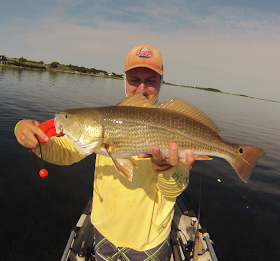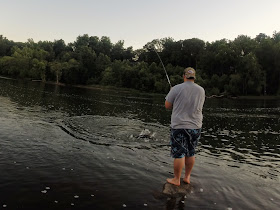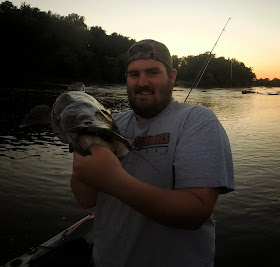Welcome to the Thunderdome
With my kayak on the operating table at Appomattox River
Company in Farmville, receiving her necessary repairs for my expedition to
Texas, I was left without a rig to continue chasing my Smallmouth Bass
citation. This has been the first time
in nearly four years since I've been without a way to get on the water; needless to
say it’s been a rather off putting period of time. With really no other option,
I decided to kick it old school and fish in the style that truly got me started
in “real deal” big game angling. That style would be wade fishing, more
specifically, wade fishing for the big beautiful beast of the boulders, the
Flathead Catfish. Now, any angler who is from here or currently resides here knows
full well of the capabilities this city has for such an activity. Richmond is
one of the few cities in the entire country where fishing of this style and
caliber are present within view of high rise office buildings and high
populated areas, an “urban oasis” in every form.
(photo: Brian Vincent)
With the weekend fast approaching, my buddy Adam and I quickly devised a
plan that would get us out on the water bright and early Saturday morning to
chase these beasts, and with any luck one of us would have a few picture worthy
fish. As we set the plan into motion I decided to give my longtime friend Jack
a call, he had been wanting to chase some flatties so this was an ample
opportunity to put him on some fish.
We all met at sunrise to catch bait, Adam and I both
running on very little sleep and Jack joining us fresh off of the night shift
with the road paving crews of I-288. Though we were reasonably sluggish, we gathered bait
pretty quickly and hit the James. We felt good about the day ahead of us. The
water was unseasonably cool for July compared to its normal bathwater temperature and the sky was ominously gray with clouds,
potentially yielding rain, ideal conditions to keep foot traffic down. Perfect
conditions for stalking a giant.
(photo: Adam Chavez)
I led us
to the first spot of the day, nicknamed “The Thunderdome” it is a very high pressured
area, although, if targeted at the correct time it could yield some very large
flatties. It wasn’t long before we got into our first fish of the day. Jack
nailed a nice cookie cutter flatty at about 36 inches, a nice way to break the
ice for both the trip, and his long flatheadless streak since moving to the
mountains and back to RVA.
It wasn’t long after the first fish when he stuck the
second.
However, this fish wasn’t playing any games. It muscled
down to the bottom of the whole, ripping drag off of the Abu 7000, using its powerful
tail to try and avoid capture. After a few moments of back talk from the beast
it was all over, Jack was awarded his second flathead since returning to
Richmond, and the first citation of his life. The big girl went a long 40
inches and a chunky 26 pounds, which is a pretty impressive feat to get a
citation weight in the middle of July, flathead just aren’t as heavy this time of
year.
The rest of the day turned out to be more of the same, Jack
landed another good fish, Adam broke off two heavy fish that took him into the
rocks, and I managed one tiny flatty…. Although, I wasn’t too disappointed in
my catch. I was more happy for Jack and relatively pleased at my ability to
guide someone to fish, adding a little promise to the potential future of me becoming
a licensed guide, but that’s neither here nor there.
Sunday we had planned to duplicate the trip from the day
before. We felt that we left some meat on the bone when it came to a few holes
so we decided to hit them again and see which individuals we left behind. I got
up a little later than originally intended and was slightly alarmed to find
that I had no missed calls or texts. Come to find out my partners in crime did
the same thing I did…. Except they extended their slumber a few hours longer.
Normally I’d be a little upset that I had to go at it alone, but I looked at this as a chance to redeem myself for the previous day.
I hit the water under the same conditions as the day
before, dreary and cool, horrible weather if you’re a hipster dude trying to “explore”
or a tan chick trying to catch melanoma….. perfect weather for a bearded fish
reaper with an eye for the big girls, flathead that is.
I targeted the all the spots in reverse, saving the
Thunderdome for last. I started off with a decent fish at about 35 inches. She
put up a good fight and even ripped a little drag, a good feeling after a few
weeks without some serious pullage.
I
arrived at the Thunderdome unsure of what to expect. We had pulled a few fish
out already and I was uncertain whether or not they’d be spooked from the
previous day. That question got answered for me about 30 second after my bait
hit the water. Instant gratification came by way of brown beast. It didn’t let
up for another 30 minutes, my bait would hit the water and wouldn’t be down
there long enough to get its bearings before it was engulfed!
After
running out of bait I decided to give it a rest. I took an hour long nap on one
of the smooth river rocks to end the day, soaking up all the good fishing from the hours
prior. It’s not too often that we come upon these days; cool weather, amazing
water, low foot traffic, great fishing, and good friends, especially in mid-July on the weekend… that’s
almost unheard of! It’s always great to have company, but I will forever cherish
the solo days on the James where there are no people to be found. Just myself,
the ancient rock of times long gone, the ever flowing water… here before us,
here after us, nature thriving in perfect harmony, as peaceful as you could
ever imagine….. until you set the hook.
Fish
Hard or Stay Home,
Josh
Dolin








.jpg)
.jpg)
.jpg)






















